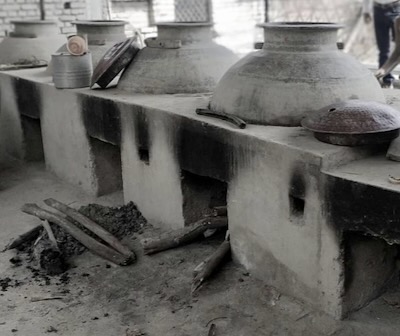As an affiliate for Bookshop, Amazon, and other programs, I may earn a small commission for products purchased through links. This doesn't affect the price you pay. Privacy policy and disclosures.
Search this site:
What Is an Attar in Aromatherapy?
An attar is a botanical hydro-distilled into a base of (usually) sandalwood oil. That is, plant material is distilled using water and the vapor released into sandalwood oil to condense. The water is then separated from the sandalwood oil. This process can take days to months to complete.
In India, almost all attars use sandalwood oil because it is a high viscosity oil with fixative properties, blends easily with all fragrances (balancing the notes), and has therapeutic benefits that enhance the therapeutic properties of the infused oil.
Attars are often used as perfume, with the advantage they contain no alcohol or synthetic ingredients, and the fragrance lasts longer than other perfumes. Attars also promote health, well-being, and happiness, and you can use them in aromatherapy similarly to using essential oils, in particular for massage and anointing.
Note: This article looks at attars from an Indian ayurvedic perspective. Other cultures also use attars. For information about attars in Arabic culture, see Jeannie Fatimeh Graham, "Attars and the Role of Fragrance in Unani Tibb Medicine," Chapter 12 in Jennifer Peace Rhind's book Fragrance and Wellbeing.
Also be aware that many synthetic approximations of attars are on the market. If you want the true experience of Indian attars, make sure you purchase pure distilled attars produced using the traditional deg-bhapka method (see Srivastava for an explanation of this process).
What Is an Attar and Its Characteristics?
Common oils also available as attars are jasmine (bela), vetiver (khus), and rose (gulab). The attar characteristics are similar to those of the essential oil.
Marma Points of Ayurveda provides the following information about other attars.
Champa Attar (Michelia champaca or Magnolia champaca)
- Rasa: Bitter, slightly sweet, and astringent
- Virya: Heating
- Vipaka: Pungent
- Dosha effects: Yellow champa is heating and beneficial for vata and kapha but may be too strong for pitta. Green champa is cooling.
- Benefits: Improves circulation, decongests sinuses, releases deep-seated emotions, elevates mood, and relieves feelings of heaviness.
Hina Attar (blend of various herbs, spices, roots, seeds in a base of mehendi (lawsonia inermi), saffron, and sandalwood)
- Rasa: Bitter, slightly pungent, sweet
- Virya: Heating
- Vipaka: Pungent
- Dosha effects: Balances all three doshas but in high doses may increase pitta in the summer.
- Benefits: Strengthens the mind and body, enhancing clarity, intuition, and psychic abilities. A rejuvenating and alternative nerve tonic with a tranquilizing effect. Improves circulation. Hina is said to open the heart chakra and third eye, awaken kundalini shakti, and unfold bhakti (devotion).
Kewra (or Kevra or Kewada or Kewda) Attar (Pandanus odoratissimus) is derived from the flowers of the tree.
- Rasa: Sweet, bitter
- Virya: Heating
- Vipaka: Sweet
- Dosha effects: Calms and balances all three doshas but increases pitta if used in excess.
- Benefits: Blood tonic, nervous system stimulant, improves circulation. Has an affinity for the heart and liver and is said to enhance bhakti and support immunity.
- Kewra has a sweet, floral fragrance with tropical undertones, reminiscent of jasmine and frangipani, according to Srivastava. More information: "Pandanus odoratissimus (Kewda): A Review on Ethnopharmacology, Phytochemistry, and Nutritional Aspects" at https://pmc.ncbi.nlm.nih.gov/articles/PMC4408760/.
Mitti is a baked earth attar, where clay is hydro-distilled into a base of sandalwood oil.
- Rasa: Sweet
- Virya: Cooling
- Vipaka: Sweet
- Dosha effects: Grounding, calming, and centering for vata. Sweet and cooling for pitta. Excessive use may elevate kapha.
- More information: https://www.atlasobscura.com/articles/smell-of-rain-kannauj-perfume-mitti-attar-india
Saffron Attar (crocus sattivus)
- Rasa: Pungent, sweet, bitter
- Virya: Slightly heating
- Vipaka: Pungent
- Dosha effects: Pacifies vata and kapha but may increase pitta.
- Benefits: Extremely balancing and beneficial for yoga and spiritual practices. Can bring clarity of perception to the mind and open the heart chakra. Improves the color of the complexion, cleans the blood, and acts as a decongestant. Has an affinity for the spleen and cerebrovascular system. Aphrodisiac. Acts on the reproductive tissue, balancing male and female hormones.
Additional attars mentioned by Srivastava:
- Samama is extracted from the resin of the Indian tree Cinnamomum bejolghota and has a warm, woody fragrance with hints of spice and sweetness.
- Majuma is a blend of natural fragrances, often including musk, sandalwood, and floral essences. It typically has a rich, complex scent profile with floral, woody, and animalic notes.
- Chandan (sandalwood) is steam-distilled from the sandalwood tree and then traditionally infused with other botanicals (like rose, jasmine, or vetiver) over months, enhancing its complexity while retaining sandalwood’s calming essence. The scent is sweet and woody, with relaxing and soothing properties.
Benefits of Attars
In addition to their dosha-balancing effects, attars have other benefits, according to the Hindu Blog:
- Cleansing the aura
- Enhancing devotion (bhakti)
- Calming the mind
- Aligning the chakras
- Promoting purity (sattva)
- Creating a sacred atmosphere
- Enhancing pranayama and meditation
Use attars during prayer or meditation, before yoga practice, or any time to cleanse your energy field (dab some attar on your wrists and neck) or balance emotions (rub a little calming attar on your palms and inhale deeply). These fragrances are also traditionally used in Vedic rituals and ceremonies.
Reference for What Is an Attar
Srivastava, Ramesh Kumar; Akanksha Tripathi; and Priyanka Singh. "Indian Attars: A traditional natural fragrance for well-being," in Indian Traditional Knowledge Through the Lens of Science (Vol II) (pp. 39–47). Chapter retrieved from https://www.researchgate.net/publication/379824597_Indian_Attars_A_traditional_natural_fragrance_for_well-being.
Buy essential oils from Aromatics International (recommended).
Rocky Mountain Essential Oils.





